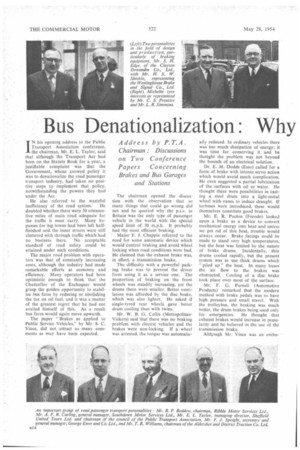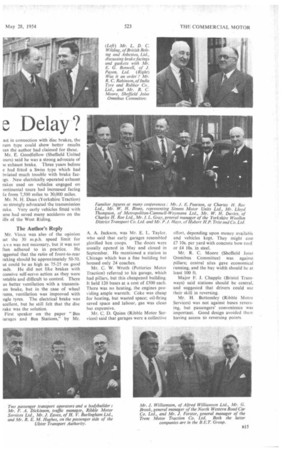Bus Denationalization Why Delay
Page 48

Page 49

If you've noticed an error in this article please click here to report it so we can fix it.
Address by P.T.A. Chairman : Discussions on Two Conference Papers Concerning Brakes and Bus Garages and Stations
IN his Opening address to the Public Transport Association conference, the chairman, Mr. E. L. Taylor, said that although the Transport Act had been on the Statute Book for a year, a justifiable complaint was that the Government, whose avowed policy it was to denationalize the road passenger transport industry, had taken no positiVe steps to implement that policy, notwithstanding the powers they had under the Act.
He also referred to the wasteful inefficiency of the road system. He doubted whether there were 50 cOnsecutive miles of main road adequate for the traffic it must carry. Many bypasses for big towns had been left halffinished and the inner streets were still cluttered with through traffic which had no business there. No acceptable standard of road safety could be attained under such conditions.
The major road problem with operators was that of constantly increasing costs, although the industry had made remarkable efforts at economy and efficiency. Many operators had been optimistic enough to think that the Chancellor of the Exchequer would grasp the golden opportunity to stabilize bus fares by reducing or abolishing the tax on oil fuel, and it was a matter of the greatest regret that he had not availed himself of this. As a result bus fares would again move upwards.
The paper "Brakes as applied to Public Service Vehicles," by Mr. S. C. Vince, did not attract as many comments as may have been expected. The chairman opened the discussion with the observation that so many things that could go wrong did not and he queried why the p.s.v. in Britain was the only type of passenger vehicle in the world with the special speed limit of 30 m.p.h. It probably had the most efficient braking.
Major F. J. Chapple referred to the need for some automatic device which would control braking and avoid wheel locking when road conditions were bad. He claimed that the exhaust brake was, in effect, a transmission brake.
The difficulty with a powerful parking brake was to prevent the driver Item using it as a service one. The proportion of braking on the front wheels was steadily increasing, yet the drums there were smaller. Better ventilation was afforded by the disc brake, which was also lighter. He asked if single-tyred rear wheels gave better drum cooling than with twins..
Mr. W. B. G. Collis (MetropolitanVickers) said that there was no braking problem with electric vehicles and the brakes were non-locking. If a wheel was arrested, the torque was automatic
ally reduced. In ordinary vehicles there was too much dissipation of energy; it was time for conserving it and he thought the problem was not beyond the bounds of an electrical solution.
Dr. E. M, Dodds (Esso) called for a form of brake with intense servo action which would avoid much complication. He even suggested a partial lubrication of the surfaces with oil or water. He thought there were possibilities in casting a steel drum into• a light-metal wheel with vanes to induce draught. If turbines were introduced, these would themselves constitute good brakes.
Mr. E. R. Pochin (Ferodo) looked upon a brake as a device to convert mechanical energy into heat and unless we got rid of this heat, trouble would always occur. Brake facings could be made to stand very high temperatures, but the heat was limited by the nature of brake drums. Incidentally, thin drums cooled rapidly, but the present system was to use thick drums which " piled up" the heat. In many buses the air flow to the brakes was obstructed. Cooling of a disc brake took place over most of the surface.
Mr. F. G. Parnell (Automotive Products) remarked that the modern method with brake pedals was to have high pressure and small travel. With the trolleybus, the braking was much better, the drum brakes being used only for emergencies. He thought that exhaust brakes would increase in popularity and he believed in the use of the transmission brake.
Although Mr. Vince was an enthu ast in connection with 'disc brakes, the rum type could show better results an the author had claimed for these. Mr. E. Goodfellow (Sheffield United ours) said he was a strong advocate of le exhaust brake. Three years before c had fitted a Swiss type which had bviated much trouble with brake facigs. New electrically operated exhaust rakes used on vehicles engaged on ontinental tours had increased facing fe from 7,500 miles to 30,000 miles. Mr. N. H. Dean (Yorkshire Traction) SO strongly advocated the transmission rake. Very early vehicles fitted with iese had saved many accidents on the ills of the West Riding.
The Author's Reply
Mr. Vince was also of the opinion tat the 30 m.p.h. speed limit for s.v.s was not necessary, but it was not ften adhered to in practice. He iggested that the ratio of front-to-rear raking should be approximately 50-50, ut could be as high as 75-25 on good }ads. He did not like brakes with ecessive self-servo action as they were astable and difficult to control. There as better ventilation with a transmison brake, but in the case of wheel rums, ventilation was improved with ngle tyres. The electrical brake was ccellent, but he still felt that the disc rake was the solution.
First speaker on the paper "Bus larages and Bus Stations," by Mr. A. A. Jackson, was Mr. E. L. Taylor, who said that early garages resembled glorified hen coops. The doors were usually opened in May and closed in September. He mentioned a station in Chicago which Was a fine building hut housed only 24 coaches, Mr. C. W. Wroth (Potteries Motor Traction) referred to his garage, which had pillars, but this cheapened building. It held 120 buses at a cost of £500 each. There was no heating, the engines providing ample warmth. Coke was cheap for heating, but wasted space; oil-firing saved space and labour, gas was clean hut expensive.
Mr. C. D. Quinn (Ribble Motor Services) said that garages were a collective
effort, depending upon money available and vehicles kept. They might cost £7 10s. per yard with concrete bow roof, or £4 10s. in steel.
Mr. R. C. Moore (Sheffield Joint Omnibus Committee) was against pillars; central sites gave economical running, and the bay width should be at least 100 ft.
Major F. J. Chapple (Bristol Tramways) said stations should be central, and suggested that drivers could use their skill in reversing.
Mr. H. Bottomley (Ribble Motor Services) was not against buses reversing, but passengers' convenience was important. Good design avoided them having access to reversing points.




































































































